She feels really easy and comfortable to sail, even in a good breeze and a chop.
- Solid construction
- Economical cruising
- Huge interior
- Family friendly
- Fast and comfortable
- Large cockpit
- Strongly constructed

A family-friendly power cat cruiser, the Leech 825 was the design of choice for international ocean sailor Daryl Wislang and his family.
While Dan Leech is a qualified naval architect with a background in competitive sailing, he understands that the commercial market is weighted towards powerboats.
And as most boat owners are averse to heeling, he’s specialised in catamaran designs. The stable comprises several variants ranging from 8.25m to 9.75m in length, and include both fuelefficient, semi-displacement models as well as performance designs.

What makes them particularly attractive are their CNC-cut components, which make for a very accurate build and considerably fewer labour hours. All designs are available as a complete package, suitable for owner-builders who have the time and skills to do it themselves. But the more popular option is a professional build, either to hull-and-decks specification or a finished turnkey package.

Ostra – a L825 performance power cat – is one of Leech’s smaller designs. Owner Daryl Wislang is a professional sailor, currently on board Dongfeng in the Volvo round the world race. Strangely enough, he also likes spending his recreation time on the water, although after the rigours of the Southern Ocean he wanted an easily managed, comfortable vessel.
He has two young children and a catamaran offers benefits that appeal to families – specifically, stability and roominess that only come with a considerably larger monohull. Also, the efficient hull profile is driven by modest powerplants – twin Yamaha 115hp four-stroke outboards for Ostra. A shallow draft also enables access into places – and even beach-parkings – off-limits to monohulls.
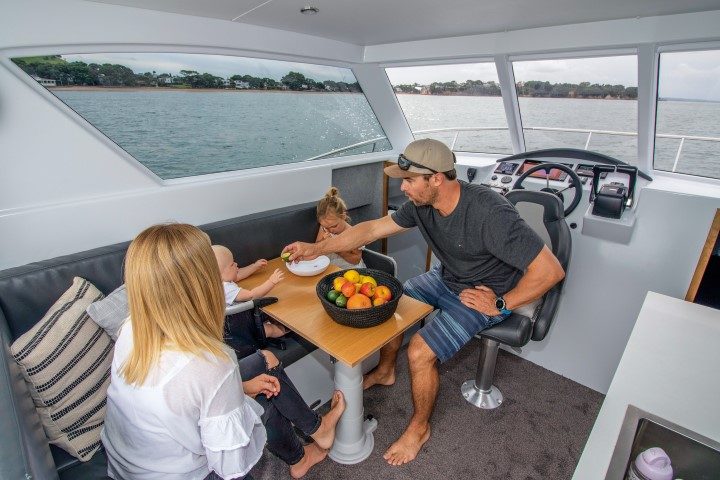
On our day with Ostra (Daryl was in Auckland during the recent race stop-over) the entire family came out for the occasion, and everyone clearly loves the boat. She’s an attractive vessel – clean lines and a simple but striking two-tone colour scheme – grey hull, white cabin and tinted windows.
CONSTRUCTION
She was professionally built in partnership with Wellington’s MG Composites, though to minimise costs Wislang was actively involved and put in many weeks of work between sailing commitments.
The hull bottom comprises three layers of 6mm meranti BS 1088 marine plywood. Sides are 12mm gaboon BS 1088 marine plywood and the hull frames are 12mm BS 1088 plywood with a 12mm plywood doubler in certain areas.
Deck and cabin are a mix of 12mm and 9mm BS 1088 plywood. Hulls are sheathed in a generous E glass/epoxy laminate inside and outside, while the hardtop’s sheathed with the same laminate on the outside. It’s all been faired and finished to a high standard. The paint system is from Resene, with Durapox epoxy urethane primer and Acrythane acrylic urethane gloss top coats.

For buyers of the design package, it comes with .dxf files for cutting the panels, a detailed 2D construction booklet and 3D step-by-step assembly computer renderings. Says Wislang: “I was instantly impressed with the way all the panels went together.”
He was also impressed by the stiffness of the resulting structure, thanks to the precision of the interlocking cross members. It all results in a high-quality build with very fine tolerances and ultimately, a robust build.
Like most cats, Ostra has a large cockpit out the back and a safe fishing platform – well off the water and protected by stainless guard rails. The rear part of the rail drops down to form a dive ladder, providing easy access for swimmers.
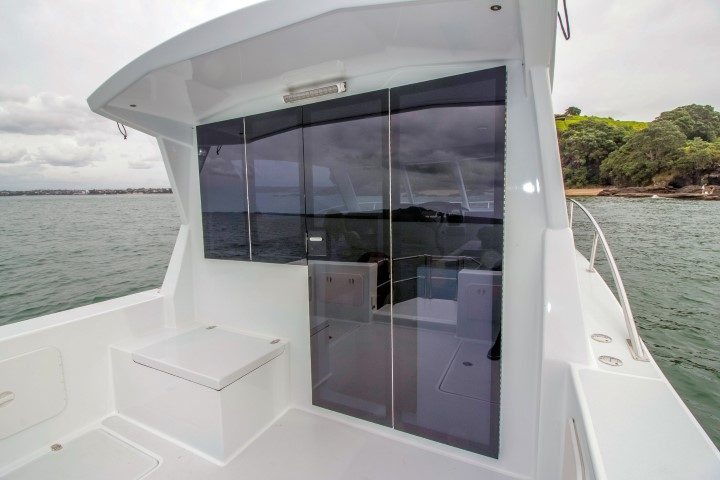
Wislang’s not a passionate fisherman and has opted for a clear and uncluttered cockpit with just a couple of rod holders. But there’s room for any number of accessories like live bait tanks, outriggers and even a game chair if required.
Large lockers in the hulls hold a variety of gear, with the 200-litre fuel tanks positioned forward of these lockers to balance weight distribution.
ACCOMMODATION
The main cabin feels elegant. Its L-shaped settee and table layout doubles as an additional twin berth when required. To starboard the galley has a sink, stove and fridge, and the helm position (located in the centre of the dash area) doesn’t impinge on access down to the cabins on either side.
I like the way the bi-fold cabin door folds flat to one side, and with the window along the rear cabin wall also opening completely, the sense of space and flow is accentuated. It makes for easy conversation across saloon and cockpit.
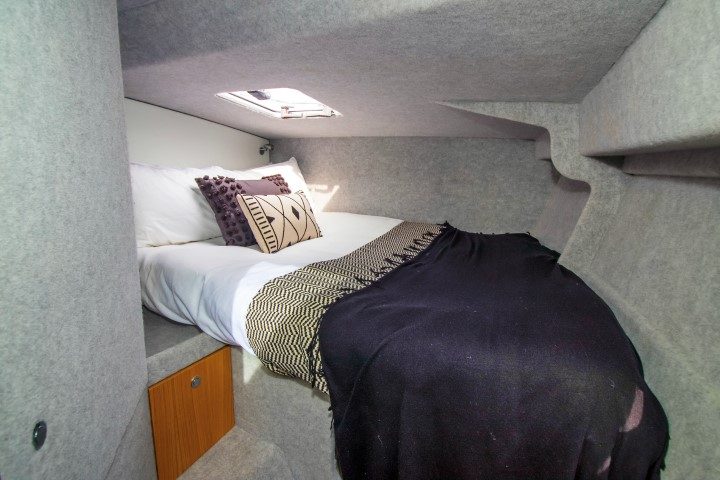
The helm seat is a padded model on a gas strut. Simrad instruments dominate the helm – a NSS9 Evo3 multifunction display, AP44 autopilot controller with colour digital display and a flush-mounted VHF radio.
Wislang opted to install CZone digital switching throughout, and just four switches control all lighting on board. A Yamaha Command Link display shows all the parameters for the twin outboards. Additional controls for the Fusion stereo and anchor capstan complete the clean and simple helm layout.
Numerous layout options are available for cabin and cockpit and Leech works with buyers to design something that works for them. For Ostra, Wislang’s sailing experience taught him that a cross-beam layout is best for a good night’s sleep: the luxurious double bed is oriented across the main cabin. A simple step-up makes for easy access, and the cabin door provides privacy.
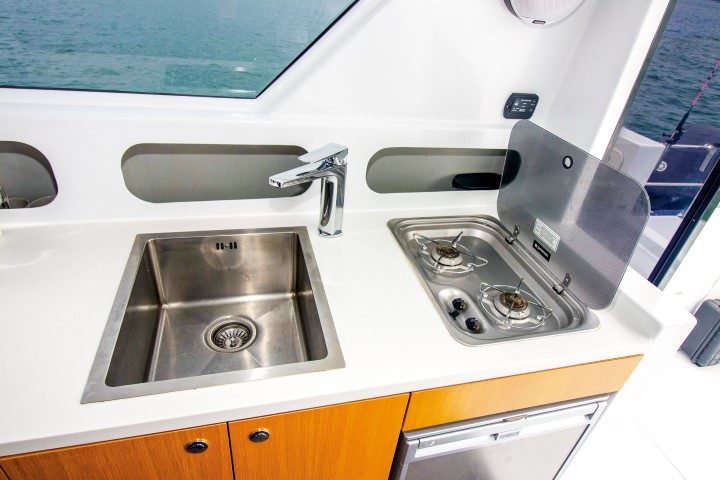
To port is a wet room with hot water shower and toilet, and a surprisingly large hand basin, more akin to an apartment than a boat. In both sides a fairly snug, single berth provides two more sleeping spaces and, with the settee in the cabin, Ostra can accommodate six.
The bow area’s protected by a stainless safety rail, and access to it is easy around the cabin sides or through the hatch in the master cabin. An automatic winch and stainless plough pick take care of the anchoring duties.
PERFORMANCE
Ostra’s dominant feature is stability. It’s immediately obvious, and with the wing-deck well clear of the water she powers through sizeable swells and waves without issue. The hard chines do a good job of keeping spray down and well away from the hull.
Pushing hard into turns, she remained flat with no outward-heel. I was pleased to see that even with the rear of the cabin completely open there was no suck-back of spray into the interior, and the high wing-deck kept spray from coming over the bows.
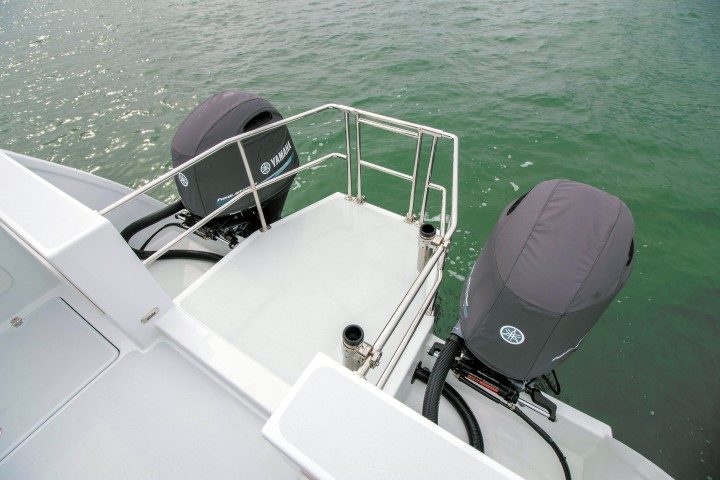
The twin Yamahas do a great job, easily pushing her to the optimum cruise speed of 23 knots at 4,500rpm. At this speed fuel consumption is around two litres per nautical mile, not bad for an 8.25m boat with three adults, two children and a couple of hundred litres of fuel on board. Engine noise isn’t intrusive – even with the rear wall completely open – conversation was easy.
Allowing for a safety margin her twin 200-litre fuel tanks offer an effective range of around 180 nautical miles, but for game fishing this would increase to over 250 nautical miles at trolling speeds. With the weather conditions and the children on board we didn’t push her to the maximum but Leech says the planing hulls give a top speed of 35 knots.
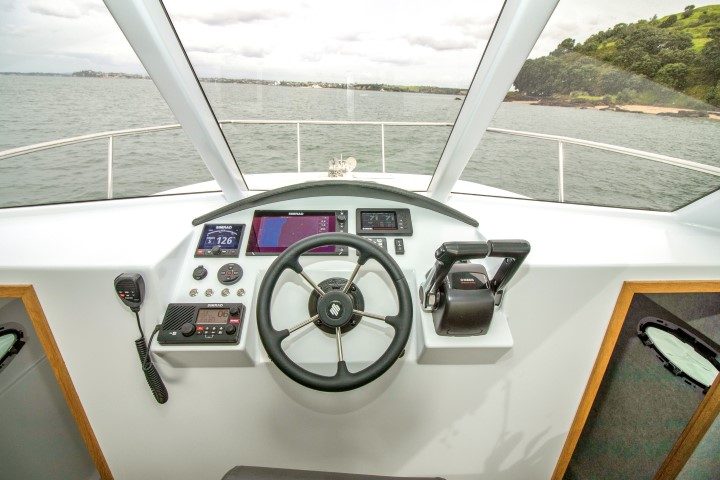
Wislang’s very pleased with the boat, and found Leech easy to work with, especially during the early stages of the build when he asked for some layout changes. “Dan was always there to talk to and bounce ideas around with, so the end product is exactly what we wanted. We love every minute we spend on the boat.”
Overall, an impressive boat. She’s the perfect entry-level power cat, ideal for family cruising. The build method is efficient and results in a very strong hull, and the level of luxury can be tailored to suit the owner. For an 8m boat, it has a huge interior and large cockpit and can be customised to suit the owner’s requirements. The design-and-build philosophy also suits a potential owner who wants to be a part of their boat’s design and build, although actual hands-on involvement is optional/>
She feels really easy and comfortable to sail, even in a good breeze and a chop.
At first glance the boat appears to be a large centre console, although hidden beneath the console and forward area is a sizeable overnight cabin.
With classic styling, good performance and class-leading ride and handling, there’s a lot to like about the Caribbean 32.
Solar panels on the vast roof help keep the batteries charged.